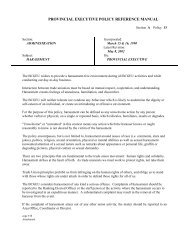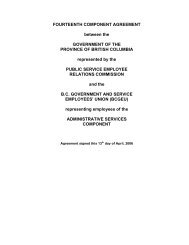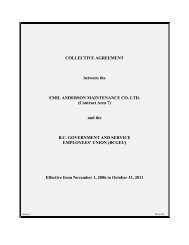DEPUTY SHERIFFS - BC Government and Service Employees' Union
DEPUTY SHERIFFS - BC Government and Service Employees' Union
DEPUTY SHERIFFS - BC Government and Service Employees' Union
- No tags were found...
Create successful ePaper yourself
Turn your PDF publications into a flip-book with our unique Google optimized e-Paper software.
The Work of Deputy Sheriffs in British Columbia, 2008:Problems <strong>and</strong> ProspectsThe following statements are taken from the comments of deputysheriffs, surveyed in August of 2008; these summaries reflect theirmost commonly expressed concerns.• The organization seems unwilling to accept that the sheriffs are incrisis at this time. Only three things can bring morale back. 1) wages2) job description – an exp<strong>and</strong>ed m<strong>and</strong>ate, 3) managerial behaviours –there is poor middle management, reluctant to change from a 'directcontrol' approach to an 'inclusive <strong>and</strong> supportive ' approach.• Jobs must inspire your pride in what you do. Fundamentally sittinglike a statue in court is boring -- rotate <strong>and</strong> train employees.• Alberta Sheriffs have a much wider range of duties <strong>and</strong> a starting wagethat is at least $10,000 more a year than us -- yet we all provide thesame duties. (There is )a lack of money <strong>and</strong> interest, which has helpedme in making my decision to move on to other employment.• One of the reasons many of us leave is out of boredom. We see whatAlberta is doing <strong>and</strong> can't underst<strong>and</strong> why we're not doing even someof that. Traffic, for example, would give us exp<strong>and</strong>ed duties whilebringing in money. Second, the wage. It’s a catch 22. Why pay usmore if we're not doing anything? Yet also not allow us to do more?• We are the most under-utilized law enforcement agency. We actuallycost the government money, instead of being a contributing agency. Ifgiven more enforcement duties, we could keep some of the newrecruits -- giving them more opportunities to exp<strong>and</strong> their career path.• Staff training is falling behind <strong>and</strong> taking a back seat because ofstaffing shortages. For example, I am entitled by policy to twofirearms practice days at the pistol range <strong>and</strong> one re-qualification shootevery 12 months. I haven’t been to the range in fourteen months. Staffsimply can’t be spared to have their training days <strong>and</strong> instructors don’thave time to train staff.• I am feeling very discontented with my job. It isn’t just a monetaryissue; sure, I would love to make more money, <strong>and</strong> who wouldn’t? Thehard thing for me is seeing this department (a valuable resource to thisprovince) being under-utilized. If sheriffs in <strong>BC</strong> were paid accordingly<strong>and</strong> had a wider range of job duties, you would see a smaller turn over1
we recognize that at least some of the concerns documented in this survey willhave been tempered by the government’s action. At the same time, however,many issues remain, <strong>and</strong> it will likely be useful for both the <strong>BC</strong>GEU <strong>and</strong> thegovernment to work together to consider further improvements to health, safety<strong>and</strong> morale in the workplace.In June of 2008 a government survey of the sheriff services division of theCourt <strong>Service</strong>s Branch, Attorney General, revealed a rather grim portrait of theworkplace environment for sheriffs, both in contrast to a portrait of the Court<strong>Service</strong>s branch, <strong>and</strong> the B.C. public service more generally (Attorney General,B.C., Court <strong>Service</strong>s Branch, Sheriff <strong>Service</strong>s Division, “Exploring EmployeeEngagement in your Work Unit”, June 2008). This June 2008 report noted thatscores below 64 were to be taken as “needing improvement” <strong>and</strong> those below 55were“challenges”. The average score for the B.C. public service was 66; theaverage score for the Sheriff <strong>Service</strong>s Division was 37, with significantweaknesses noted in virtually every category of concern: organizationalsatisfaction, pay <strong>and</strong> benefits, staffing practices, employee engagement,empowerment, vision, mission <strong>and</strong> goals, recognition, <strong>and</strong> professionaldevelopment.A short description of the work of deputy sheriffs is an importantintroduction to our own survey. In 2008 the deputy sheriffs of B.C. provide avariety of services; these services might best be summarized as falling into one offour areas: prisoner escort services, guarding <strong>and</strong> care of prisoners, courtroomsecurity, <strong>and</strong> jury management. More specifically, those providing escort servicestransport accused <strong>and</strong> convicted individuals from police stations <strong>and</strong> correctionalinstitutions to courthouses, <strong>and</strong> from courthouses to institutions. Those who guard<strong>and</strong> care for prisoners ensure appearance in court, conduct necessary searches ofprisoners, <strong>and</strong> act in concert with those working in corrections <strong>and</strong> courthouses.Those who offer courtroom security services monitor the courtroom during trials,providing a measure of safety for the judge, jury <strong>and</strong> general public. Thoseinvolved in jury management assist with the movement of the jury pool duringjury selection, <strong>and</strong> ensure the safety of the jury within the courtroom. It isimportant to note that some sheriffs may take on a range of these tasks, whileothers may specialize in one particular kind of work. There are clearly times whendeputy sheriffs are vulnerable to prisoner violence, as time loss claims reveal.The purpose of the report that follows is to examine the problemsencountered by British Columbia's deputy sheriffs, as described by them inAugust of 2008.A Survey of Deputy Sheriffs: August 2008In August of 2008 we constructed a survey, in consultation with thecorrectional component of the British Columbia <strong>Government</strong> Employees <strong>Union</strong>(<strong>BC</strong>GEU). This survey was responded to by 225 deputy sheriffs working in the3
Lower Mainl<strong>and</strong> region, Vancouver Isl<strong>and</strong> region, <strong>and</strong> Prince George region. Thefollowing three charts provide a breakdown of the gender, age, <strong>and</strong> workingregions of those who responded.GenderMaleFemaleTotalFrequency Per cent191 84.934 15.1225 100.0Age Range18-24 years25-34 years35-45 years46 or OlderTotalFrequency Per cent7 3.156 24.9101 44.961 27.1225 100.0Work LocationLower Mainl<strong>and</strong>Prince George <strong>and</strong> vicinityOkanagan <strong>and</strong> vicinityVancouver Isl<strong>and</strong> <strong>and</strong>vicinityOtherTotalFrequency Per cent152 67.617 7.61 .448 21.37 3.1225 100.0The kind of work undertaken by deputy sheriffs is mostly a mix of prisoner escortservices, courtroom security, <strong>and</strong> the guarding <strong>and</strong> care of prisoners. As thefollowing chart makes clear, while there are some deputy sheriffs who workexclusively in one area, most of those who responded to our survey appear tohave overlapping responsibilities.4
The level of prisoner to prisoner violence in myworkplace has not risen over the past 3 yearsstrongly disagreedisagreeagreestrongly agreeTotalFrequency Per cent63 32.082 41.648 24.44 2.0197 100.0When we asked deputy sheriffs about their personal sense of safety on the job, we foundthat a majority (53.6 per cent) do not feel safe in their workplace. Further, when we askedsheriffs about their own experiences in the past year, we found that most had witnessedacts of workplace violence, or threats of workplace violence, as the charts belowdemonstrate.I do not feel safe doing my jobstrongly disagreedisagreeagreestrongly agreenot applicableTotalFrequency Valid Percent3 1.497 43.790 40.529 13.13 1.4222 100.0In the past year, have you witnessed anact if workplace violence - verbal threats?NoYesTotalFrequency Per cent43 19.2181 80.8224 100.0In the past year, have you witnessed an actif workplace violence - physical assaults?NoYesTotalFrequency Per cent67 30.0156 70.0223 100.08
These results raise significant concerns about workplace safety for deputy sheriffs inBritish Columbia, <strong>and</strong> point to the logic of the deputy sheriffs citing staffing <strong>and</strong>workload as greater concerns than wages. A significant literature has developed duringthe past two decades regarding job stresses, job risks <strong>and</strong> job satisfaction amongcorrectional officers. Although this research did not focus on deputy sheriffs, there aresufficient similarities in the nature of the work to justify consideration of such findings todate from Canada <strong>and</strong> other jurisdictions.It seems clear that the greatest risks for deputy sheriffs arise from the escort, guarding<strong>and</strong> care of prisoners; courtroom security <strong>and</strong> jury management are typically lesscontentious kinds of work, at least in relation to perceived risks of harm <strong>and</strong> threats topersonal safety. Dowden <strong>and</strong> Tellier (2004) found in a Canadian study that work attitudes(participation in decision-making, job satisfaction, organizational commitment <strong>and</strong>intention to leave the workplace) were highly correlated with job stress. Greatercommitment, participation <strong>and</strong> job satisfaction were correlated with lower rates of jobstress; intention to leave was correlated with higher rates of job stress. Additionally, somespecific problems in the workplace (perceived dangerousness <strong>and</strong> role conflicts)generated job stress.This research points to the importance of increasing participation in decision-making,increasing individual commitment to the organization <strong>and</strong> addressing specific perceptionsof dangerousness among the employee population. In the context of deputy sheriffs, thiswould appear to imply a more systematic attempt to address safety issues connected withthe escorting, guarding <strong>and</strong> care of prisoners; a number of these safety issues may bestrongly linked to issues of staff deployment. Current responses to questions regardingjob stress indicate that these kinds of concerns are pervasive. The following chartdemonstrates that more than 75 per cent of deputy sheriffs strongly agree or agree thatjob stress has increased during the past three years. A further chart indicates thatimprovements to job satisfaction will require more than adjustments to rates of pay;almost half of those responding point to problems with job satisfaction, independent ofthe issue of wages.My level of on-the-job stress has gone up overthe past 3 yearsstrongly disagreedisagreeagreestrongly agreenot applicableTotalFrequency Per cent3 1.420 9.070 31.799 44.829 13.1221 100.09
My job provides me with a significant amount ofjob satisfacton, apart from the issue of rate of paystrongly disagreedisagreeagreestrongly agreenot applicableTotalFrequency Per cent38 17.062 27.893 41.728 12.62 .9223 100.0With respect to decision-making, while a significant number of deputy sheriffs point toregular meetings of occupational health <strong>and</strong> safety committees, they also point toconcerns about the effectiveness of these meetings over time, <strong>and</strong> the extent to which thevalue of these meetings might be improved upon. The two charts that follow note thatwhile a clear majority indicates that occupational health <strong>and</strong> safety committees aremeeting regularly, only 40 per cent agree that the committees are working well <strong>and</strong>addressing critical issues within the workplace.My occupational safety <strong>and</strong> health committeemeets regularly to consider concerns aboutworkplace health <strong>and</strong> safetystrongly disagreedisagreeagreestrongly agreenot applicableTotalFrequency Per cent15 7.156 26.7104 49.59 4.326 12.4210 100.0My occupational safety <strong>and</strong> health committee is workingwell <strong>and</strong> tries to address critical issues in my workplacestrongly disagreedisagreeagreestrongly agreenot applicableTotalFrequency Per cent34 16.366 31.680 38.36 2.923 11.0209 100.0Discussion:10
There is no doubt that deputy sheriffs regard the 9.2 per cent market adjustments ofSeptember, 2008 as a positive first step. Many of the concerns expressed in this surveyregarding the wages of deputy sheriffs will have been at least partially offset by thisincrease. On the other h<strong>and</strong>, it is clear that a number of key issues remain, <strong>and</strong> we cannotbe confident that the recent market adjustment will fully address issues of recruitment anretention. The issues that are now of greatest concern to deputy sheriffs might beeffectively summarized as workplace safety (particularly in relation to the transporting,care <strong>and</strong> guarding of prisoners), workplace stress, the potential for improvement in thefunctioning <strong>and</strong> output of occupational health <strong>and</strong> safety committees, <strong>and</strong> the potentialfor improvement in job responsibilities (notably, increasing the role of the deputy sheriff,in a manner congruent with deputy sheriffs in the province of Alberta).The June, 2008 document of the Attorney General’s Ministry, “Exploring EmployeeEngagement in Your Work Unit”, noted significant deficiencies within the Sheriff<strong>Service</strong>s Division in organizational satisfaction, pay <strong>and</strong> benefits, staffing practices,employee engagement, recognition, <strong>and</strong> professional development. If we are to put aside,for the moment, the issue of pay <strong>and</strong> benefits, we must recognize that a number ofsignificant issues remain. It is hoped that this report might provide an impetus forimproved collaboration between the union <strong>and</strong> the government with respect toamelioration of these difficulties. Issues of staffing, specific to the escort, care <strong>and</strong>guarding of prisoners, improvements in the functioning of occupational health <strong>and</strong> safetycommittees, potential increases in the scope of responsibilities for deputy sheriffs,effective means of addressing issues of workplace stress: these are all concerns that mustbe met if the deputy sheriffs service of British Columbia is to be able to continue to servethe citizens of British Columbia with a high level of professional commitment.References11
Attorney General of British Columbia, Court <strong>Service</strong>s Branch, Sheriff <strong>Service</strong>s Division,“Exploring Employee Engagement in your Work Unit”, B.C. Public Sector, June 2008,23pp.Castle, Tammy, “Satisfied in the Jail? Exploring the Predictors of Job SatisfactionAmong Jail Officers”, 33 Criminal Justice Review 48-63, March 2008.Dowden, Craig, <strong>and</strong> Tellier, Claude, “Predicting work-related stress in correctionalofficers: A meta-analysis”, 32 Journal of Criminal Justice 31-47, 2004.Worksafe B.C.http://www.worksafebc.ca/publications/reports/statistics_reports/occupational_injuries/1997-2006/assets/pdf/Table%209G0-9G7.pdf)/12
The Work of Deputy Sheriffs in BritishColumbia, 2008:A Membership SurveyThis survey is part of a research project that is looking at how work practices <strong>and</strong>conditions of employment are affecting the safety <strong>and</strong> job security of Deputy Sheriffs,<strong>and</strong> the public interest. In addition to this survey, we will carry out in-depth interviews<strong>and</strong> analysis of available documents. Specific issues that will be examined include, butare not limited to, the following:• Recruitment <strong>and</strong> retention• Training• Transporting prisoners/working alone• Guarding <strong>and</strong> care of prisoners• Courtroom security• Incidents of violence• Biohazards• WCB claims• Operation of Occupational Safety <strong>and</strong> Health CommitteesThe principal researcher commissioned by the <strong>BC</strong>GEU is a professor at Simon FraserUniversity’s School of Criminology, <strong>and</strong> has no ties to the <strong>BC</strong>GEU. The results of thissurvey will be submitted to the Correctional <strong>and</strong> Sheriff <strong>Service</strong>s, Component 1 of the<strong>BC</strong>GEU. Participants may obtain electronic copies of the results from Neil Boyd,nboyd@sfu.ca. There are no known risks attached to responding to this questionnaire; thebenefits are: increased knowledge <strong>and</strong> underst<strong>and</strong>ing regarding the issues noted above.This study is supported by your union, but permission has not been sought from youremployer.Your VOLUNTARY participation marks an important step in the successful completionof this project. Please be assured that everything collected in the course of this researchproject is COMPLETELY CONFIDENTIAL AND YOUR IDENTITY WILLREMAIN ANONYMOUS. Please do not identify yourself in your answers. This surveyis in compliance with the research ethics guidelines as established by Simon FraserUniversity. All research materials, data, survey data, communications, interview notes orany other data will be held in confidence by the researchers, Neil Boyd <strong>and</strong> Isabel Otter.If you have any questions, or comments, we may be reached by email at: nboyd@sfu.caor Isabelotter@shaw.ca or by phone/voice mail (778-782-3324). If you have anyconcerns or complaints about this survey you can address these to Hal Weinberg,hal_Weinberg@sfu.ca or 778-782-3447.13
Please send your completed survey or any written correspondence to the person whogave it to you. Alternatively, you may also mail your survey directly to ProfessorNeil Boyd, School of Criminology, ASSC 1, Simon Fraser University, Burnaby, B.C.V5A 1S6Thank you for your time <strong>and</strong> consideration in completing this survey.14
Part 1: BackgroundThe Work of Deputy Sheriffs inBritish Columbia, 2008:A Membership SurveyIn order to underst<strong>and</strong> a little bit about your service background, we need to ask a fewbasic questions. Please tick appropriate answer.Q01. What is your gender? Male FemaleQ02. What was your age in years, as of May 1, 2008? 18-24 25-34 35-45 46 or OlderQ03A. I work primarily inQ03. Please indicate where you work. Lower Mainl<strong>and</strong> Prince George <strong>and</strong> vicinity Okanagan <strong>and</strong> vicinity Vancouver Isl<strong>and</strong> <strong>and</strong> vicinity Other, please specify:____________________________________ Courtroom Security Prisoner Escort, Ground <strong>and</strong> Air Holding Cell securityA combination, pleasespecify:____________________________________Q04. Please indicate approximately how long you have worked as aDeputy Sheriff. Less than one year One to two years Three to five years Six to nine years Ten to fifteen years Sixteen or more years15
Q05. What is the highest level of formal education that you have completed? Less than High School Diploma High School Diploma One-Year Certificate Two-Year Diploma Four-Year Degree Graduate DegreeQ06. Please list any other career training you may have:___________________________________________________________________________________________________________________________________________________________________________________________________________________________Q07. Do you work at more than one job – at another job, in addition to your workas a deputy sheriff? If yes, please specify, indicating the number of hours per weekcommitted to a second job.___________________________________________________________________________________________________________________________________________________________________________________________________________________________Q08. How long do you intend on working as a deputy sheriff? less than 1 year 1-5 years 6-10 years Until I retireQ08A. If 5 years or less, please indicate why you would leave your job asa deputy sheriff.__________________________________________________________________________________________________________________________________________________Q09. How many times in the past year have you been exposed to chemical or biohazardoussubstances in your workplace within the past three years?TypeNumber of occurrencesQ09a. BloodQ09b. FecesQ09c. SalivaQ09d. UrineQ09e. VomitQ09f. Other, please specify:_____________________Q09g. Chemicals, please specify: __________________________________________________________________16
Q10. Have you ever taken time off from work due to chemical or bio-hazardoussubstance exposure in the workplace? Yes NoIf you answered no to question 10, please go on to question 13 of this survey. If youanswered yes, complete questions 11 <strong>and</strong> 12 below:Q11. How much time have you taken off from work due to chemical or biohazardoussubstance exposure in the workplace in the past year? None 1 – 2 days 3 – 5 days 6 – 10 days 11 – 15 days Over 15 daysQ12. Through what means did you take time off from work due to chemical or biohazardoussubstance exposure in the workplace? WCB claim sick leave another form of absence, specify_____________17
Q13. How many times in the past year have you feared for your safety? If once, ormore than once, provide details below.TypeNumber of occurrencesQ13a. Written threatQ13b. Verbal threatQ13c. Threatening gestureQ13d. Physical assaultQ13e. Assault with weaponQ13f. Other, please specify:_______________________________________________________________Q14. How many times in the past year have you witnessed an act of workplaceviolence? (i.e. witnessed prisoner on prisoner violence or other violence in yourworkplace). If once or more than once, provide details below.TypeNumber of occurrencesQ14a. Written threatQ14b. Verbal threatQ14c. Threatening gestureQ14d. Physical assaultQ14e. Assault with weaponQ14f. Other, please specify:_______________________________________________________________Q15. Have you ever taken time off from work due to an act of violence in theworkplace? Yes NoIf you answered no to question 15, please go on to question 18 of this survey. If youanswered yes, complete questions 16 <strong>and</strong> 17 below:Q16. How much time have you taken off from work due to an act of violence in theworkplace within the past year? None 1 – 2 days 3 – 5 days 6 – 10 days 11 – 15 days Over 15 daysQ17. Through what means did you take time off from work due to an act of violencein the workplace? WCB claim sick leave another form of absence, specify_____________18
Q18. Have you ever taken time off from work due to work-related stress? Yes NoIf you answered no to question 18, please go on to question 21. If you answered yes,complete questions 19 <strong>and</strong> 20 below:Q19. How much time have you taken off from work due to work-related stress in thepast year? None 1 – 2 days 3 – 5 days 6 – 10 days 11 – 15 days Over 15 daysQ20. Through what means did you take time off from work due to work-relatedstress? Describe the nature of the stress. WCB claim sick leave another form of absence, specify ________________19
Part 2: PerceptionsThis section asks you to comment on a number of work related issues. If a question isinappropriate, or you are unsure how to fit your experience into the confines of thequestion at h<strong>and</strong>, please tick “not applicable”, or provide a short written comment at theappropriate question.Q22. Please indicate your degree of agreement (Strongly Agree to StronglyDisagree) with the following statements.Q22a. The current level of staffing makes myworkplace unsafe.NotApplicableStronglyAgreeAgreeDisagreeStronglyDisagree• • • • •Q22b. Court <strong>Service</strong>s <strong>BC</strong> policies on staffinglevels for Sheriffs have changed for the better • • • • •over the past year.Q22c. Court <strong>Service</strong>s <strong>BC</strong> policies on staffinglevels for Sheriffs have changed for the better • • • • •over the past 3 years.Q22d. The possibility of violence in myworkplace has not risen over the past year.• • • • •Q22e. The threat of violence in my workplacehas not risen over the past 3 years.• • • • •Q22f. The level of prisoner to prisonerviolence in my workplace has not risen over • • • • •the past year.Q22g. The level of prisoner to prisonerviolence in my workplace has not risen over • • • • •the past 3 years.Q22h. My occupational safety <strong>and</strong> healthcommittee meets regularly to consider• • • • •concerns about workplace health <strong>and</strong> safety.Q22i. My occupational safety <strong>and</strong> healthcommittee is working well <strong>and</strong> tries to• • • • •address critical issues in my workplace.Q22j. The new recruits in my workplace(those hired in the last two years) will, intime, become accomplished as deputy• • • • •sheriffs.Q22k. I feel that I have received adequatetraining for my job.• • • • •Q22l. My job provides me with a significantamount of job satisfaction, apart from the • • • • •issue of rate of pay.Q22m. I do not feel safe doing my job. • • • • •20
Not ApplicableStronglyAgreeAgreeDisagreeQ22n. My level of on-the-job stress has gone up over the pastyear. • • • • •Q22o. My level of on-the-job stress has gone up over the past 3years. • • • • •Q22p. Problems relating to staffing levels for escorts have notincreased over the past year. • • • • •Q22q. Problems relating to staffing levels for escorts have notincreased over the past three years. • • • • •StronglyDisagreeQ22r. I am actively looking for alternative employment at thepresent time. • • • • •Q23. What are the three most important concerns that you currently haveregarding work practices <strong>and</strong> conditions of employment for deputy sheriffs?1. ____________________________________________________________2. ____________________________________________________________3. ____________________________________________________________21
Q24. Please include any comments you wish to make below.Thank-you for your participation in this survey22
















